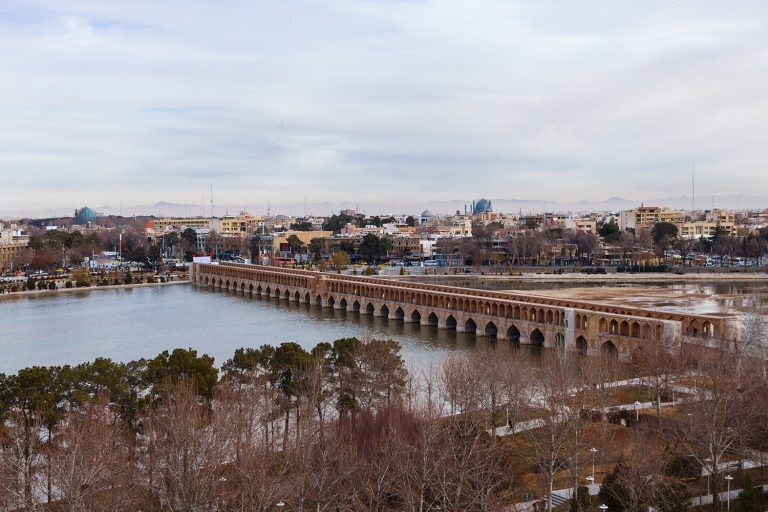Siosepol or the Allahverdi Khan Bridge with 33 spans, 295 meters in length and 14 meters in width, which was built by Allahverdi Khan on Zayandehrud in Isfahan city, at the same time as Shah Abbas I Safavi. The idea of the construction of the Siosepol Bridges was between 1599-1602. And in 1602, Allahverdi Khan Undiladze Gorji, his famous commanding officer, completed the construction of the Bridge. Siosepol Bridge which of its kind is an unimpressive masterpiece of the monarchy of Shah Abbas I.
The travel guides of the European Tourists in that era are good references to describe of the Siosepol. There was a celebration held on every July 13, people were taking part in the ceremony by sprinkling water and rose water. The Armenians of Jolfa of Isfahan also held their lava rituals in the same Bridge. This Bridge is one of the masterpieces of Iran’s architecture and is unique in its beauty and majesty. During the Safavid period, the ceremony was held at the Abrazan or Armenian waterfalls along the Bridge. The Armenians of Julfa also held the Khajuan ceremony along the same Bridge. The Bridge is one of the architectural and Bridge masterpieces of Iran and the world.
The Bridge is very wide, long and high, its foundation is poured with stone, lime and rose with bricks and plaster. The middle way that has been special for the ride and the wheels. The three sides of the Bridge, passing through the beautiful galleries, were assigned to the sidewalk. 4 and 5 of the galleries of the two farther fronts, when it was flooded was a magnificent promenade. Finally, the galleries of the Bridge were connected by the elegant steps of the Bridge and passed through and under the Bridge. Seven craters of this Bridge have been built and now have 33 craters and are therefore known as the Bridge of 33 springs. This Bridge has had different names such as Pole Shah Abbasi, Pole Allahverdikhan, Pole Jolfa, Pole Chehelscheshme, Pole 33 cheshmeh. It has become famous for the Bridge of Allahvedrikhan, and because of the fact that the people of Jolfa have been affected by it, they also have said it as the Bridge of Jolfa. In the beginning, it had forty springs so it was called Bridge of forty springs and now it has 33 springs and it is called a Bridge of 33 springs. The Bridge of Allahverdi Khan is connected to The magnificent street of Chaharbagh. In the Safavid period, the Armenians had the right to gather up the area constructed first by the Bridge and to trade their property and their industries with isfahanian artisans, and they did not have the right to cross the Bridge through the city. There are six passage-way on this Bridge: one in the middle and four on each side, which every passage-way has narrow stairs go under the Bridge. It can be said It is the most beautiful industry and the masterpiece of Iran’s building. The great Bridge consisting of forty springs in a special way, which, when flooding the whole water, it looks like a spring. It comes to pass, that the two streets should be connected to each other.
This beautiful building, which has survived despite its great time and natural and historical events, is worth the visit Esfahan, although it is likely that nobody is expected to see the most magnificent Bridge in the world.
There are two passage-ways on the Bridge and under the Bridge. From on the Bridge, you can see a better view of the river and the city, but under the Bridge is has perfect to walk and sit. You can also walk and ride a bicycle through along on the Bridge. It is the best place to go in your free time and take amazing photos.


